#space launch system
Explore tagged Tumblr posts
Text
ALT: This video shows blades of grass moving in the wind on a beautiful day at NASA’s Michoud Assembly Facility in New Orleans. In the background, we see the 212-foot-core stage for the powerful SLS (Space Launch System) rocket used for Artemis I. The camera ascends, revealing the core stage next to a shimmering body of water as technicians lead it towards NASA’s Pegasus barge. Credit: NASA
The SLS (Space Launch System) Core Stage by Numbers
Technicians with NASA and SLS core stage lead contractor Boeing, along with RS-25 engines lead contractor Aerojet Rocketdyne, an L3Harris Technologies company, are nearing a major milestone for the Artemis II mission. The SLS (Space Launch System) rocket’s core stage for Artemis II is fully assembled and will soon be shipped via barge from NASA’s Michoud Assembly Facility in New Orleans to the agency’s Kennedy Space Center in Florida. Once there, it will be prepped for stacking and launch activities.
Get to know the core stage – by the numbers.

Standing 212 feet tall and measuring 27.6 feet in diameter, the SLS core stage is the largest rocket stage NASA has ever built. Due to its size, the hardware must be shipped aboard NASA’s Pegasus barge.

900 miles
Once loaded, the barge – which was updated to accommodate the giant core stage -- will travel 900 miles to Florida across inland and ocean waterways. Once at Kennedy, teams with our Exploration Ground Systems team will complete checkouts for the core stage prior to stacking preparations.

18 Miles + 500 Sensors
As impressive as the core stage is on the outside, it’s also incredible on the inside. The “brains” of the rocket consist of three flight computers and special avionics systems that tell the rocket what to do. This is linked to 18 miles of cabling and more than 500 sensors and systems to help feed fuel and steer the four RS-25 engines.

8.8 million
Speaking of engines… Our SLS Moon rocket generates approximately 8.8 million pounds of thrust at launch. Two million pounds come from the four powerful RS-25 engines at the base of the core stage, while each of the two solid rocket boosters produces a maximum thrust of 3.6 million pounds. Together, the engines and boosters will help launch a crew of four Artemis astronauts inside NASA’s Orion spacecraft beyond Earth orbit to venture around the Moon.

733,000 Gallons
Achieving the powerful thrust required at launch calls for a large amount of fuel - 733,000 gallons, to be precise. The stage has two huge propellant tanks that hold the super-cooled liquid hydrogen and liquid oxygen that make the rocket “go.” A new liquid hydrogen storage sphere has recently been built at Kennedy, which can store 1.25 million gallons of liquid hydrogen.

Four
The number four doesn’t just apply to the RS-25 engines. It’s also the number of astronauts who will fly inside our Orion spacecraft atop our SLS rocket for the first crewed Artemis mission. When NASA astronauts Reid Wiseman, Christina Koch, and Victor Glover along with CSA astronaut Jeremy Hansen launch, they will be the first astronauts returning to the Moon in more than 50 years.
Make sure to follow us on Tumblr for your regular dose of space!
964 notes
·
View notes
Text

"NASA Stennis Teams Install New Production RS-25 Engine for Upcoming Hot Fire
NASA marked a key milestone Feb. 18 with installation of RS-25 engine No. E20001, the first new production engine to help power the SLS (Space Launch System) rocket on future Artemis missions to the Moon.
The engine, built by lead SLS engines contractor L3Harris (formerly Aerojet Rocketdyne), was installed on the Fred Haise Test Stand in preparation for acceptance testing next month. It represents the first of 24 new flight engines being built for SLS flights, beginning with Artemis V.
In this image, teams at NASA Stennis deliver, lift, and install the first new production RS-25 engine on the Fred Haise Test Stand on Feb. 18."
Credit: NASA/Danny Nowlin
Date: February 18, 2025
Posted on Flickr by "NASA's Marshall Space Flight Center": link
#Artemis V#Artemis 5#Space Launch System#SLS#Rocket#Artemis program#NASA#Marshall Space Flight Center#MSFC#Huntsville#Alabama#February#2025#my post
79 notes
·
View notes
Text





NASA's Vehicle Assembly Building (VAB), viewed from the Kennedy Space Center bus tour. Built for the Apollo program to complete the assembly of the Saturn V rockets, the building now plays host to the Artemis program's Space Launch System.
102 notes
·
View notes
Video
Marshall Space Flight Center's 65th Anniversary by NASA's Marshall Space Flight Center Via Flickr: In 2025, Marshall Space Flight Center will be celebrating our 65th anniversary! All year long, we will be showcasing the past, present, and future work at our center. From the Earth, to the Moon, Mars, and beyond. Follow us and stay tuned! In this image, the Shuttle Orbiter Enterprise is removed from the Marshall Center's Dynamic Test Stand following its first Mated Vertical Ground Vibration test (MVGVT) in 1978. The tests marked the first time ever that the entire shuttle complement (including Orbiter, external tank, and solid rocket boosters) were mated vertically. Credits: NASA #NASA #space #NASAMarshall #sls #spacelaunchsystem #nasasls #rockets #exploration #artemis #SpaceShuttle More about NASA's Marshall Space Flight Center NASA Media Usage Guidelines
#NASA#Marshall Space Flight Center#MSFC#rocket#space#Artemis#Space Launch System#Moon2Mars#Space Shuttle#ORBITER#DYNAMIC TEST STAND#flickr
9 notes
·
View notes
Text
SLS reaches MACH 23 (faster than 17,000 MPH)
in just 8.5 MINUTES.

#space launch system#space photography#space shuttle#outer space#space#science#space exploration#james webb space technology#sky#astronomy#nasa#astronomers#universe#nasa photos#astrophotography#astrophysics#nasawebb#hubble space telescope#nasa science#science facts#planetary science#space science#planetary nebula#our universe#astronomy facts#nasa astronauts#nasa jpl#nasaastronaut#nasa picture of the day#rocket launch
12 notes
·
View notes
Text

Up into orbit and back down again. ✨🌛🚀 🪐 💫
#astronaut#astronomers#astronomy#saturn#space ship#space shuttle#outer space#rocket ship#space x#space x dragon#crew 9#elon musk#rocket#rockets#constellations#orbit#cosmos#meteor shower#comets#iss#space station#space launch system#space#deep space exploration#cape canaveral#hubble space telescope#hubble telescope#planets#nasa#space baby
6 notes
·
View notes
Text
First engine installed on Artemis 2 Moon rocket
The installation of RS-25 engine E2059 at the base of the core stage for NASA’s second Space Launch System rocket. Credit: NASA Technicians have installed the first engine on the core stage of the second Space Launch System rocket, which is tasked with sending the first people to the Moon in more than a half century. Continue reading Untitled

View On WordPress
14 notes
·
View notes
Text
youtube
First Man: Neil Armstrong
#first man neil armstrong#first man movie#first man film#damien chazelle#la la land#whiplash movie#astronauts#astronaut#first man 2018#lunar module#nasa#nasa mission#nasa mars#nasa moon#apollo#apollo 11#apollo 13#apollo 14#apollo 10#apollo 18#saturn v#cosmonaut#space walk#space rocket#space launch system#rocket launch#mission moon#mission mars#space mission#Youtube
2 notes
·
View notes
Text
Anybody else pissed off that Katy Perry going to space?! It's so annoying
Tf this bitch do ☠️
She's a celebrity and it discredits the hard working STEM ppl tf
#physics#astro community#astronomy#space#space launch system#spacelovers#mission#confused#annoyed#tilted#stemblr#women in stem#stem academia#stem
4 notes
·
View notes
Text
NASA’nın Artemis Ay Görevi Ertelendi, Boeing 400 Çalışanı İşten Çıkarıyor!
🚀 NASA’nın Artemis programındaki gecikmeler, uzay endüstrisini sarsıyor! 📌 Boeing, Space Launch System (SLS) programındaki 400 çalışanın işine son veriyor! 📌 NASA’nın Ay’a insan gönderme planı 2026’ya ertelendi! 📌 Artemis II ve III misyonları bütçe sorunları ve teknik aksaklıklar nedeniyle gecikti! 🔎 Peki, bu ertelemeler uzay araştırmalarını nasıl etkileyecek? İşte tüm detaylar! Boeing, NASA’nın…
#Artemis programı#Boeing#Elon Musk#işten çıkarmalar#NASA#SLS#Space Launch System#SpaceX#uzay araştırmaları#uzay politikası
0 notes
Text
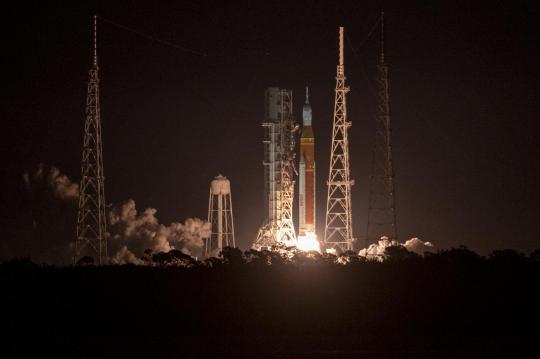
Moonbound: One Year Since Artemis I
On this day last year, the Artemis I rocket and spacecraft lit up the sky and embarked on the revolutionary mission to the Moon and back. The first integrated flight test of the rocket and spacecraft continued for 25.5 days, validating NASA’s deep exploration systems and setting the stage for humanity’s return to the lunar surface.

On Nov. 16, 2022, the Space Launch System (SLS) rocket met or exceeded all expectations during its debut launch on Artemis I. The twin solid rocket booster motors responsible for producing more than 7 million pounds of thrust at liftoff reached their performance target, helping SLS and the Orion spacecraft reach a speed of about 4,000 mph in just over two minutes before the boosters separated.
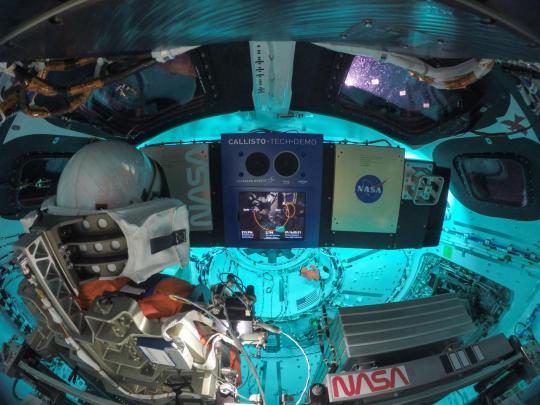
Quite a few payloads caught a ride aboard the Orion spacecraft on the Artemis I mission: In addition to a number of small scientific satellites called CubeSats, a manikin named Commander Moonikin Campos sat in the commander’s seat. A Snoopy doll served as a zero-gravity indicator — something that floats inside the spacecraft to demonstrate microgravity.
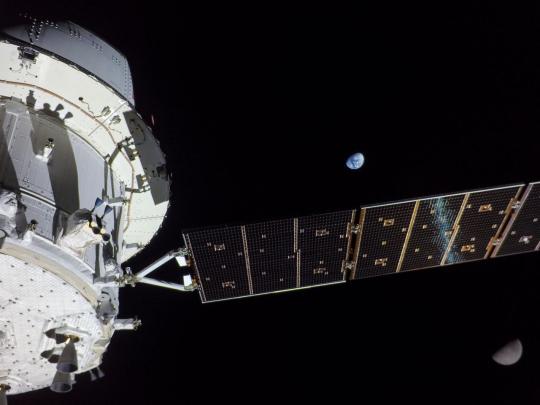
During the mission, Orion performed two lunar flybys, coming within 80 miles of the lunar surface. At its farthest distance during the mission, Orion traveled nearly 270,000 miles from our home planet, more than 1,000 times farther than where the International Space Station orbits Earth. This surpassed the record for distance traveled by a spacecraft designed to carry humans, previously set during Apollo 13.
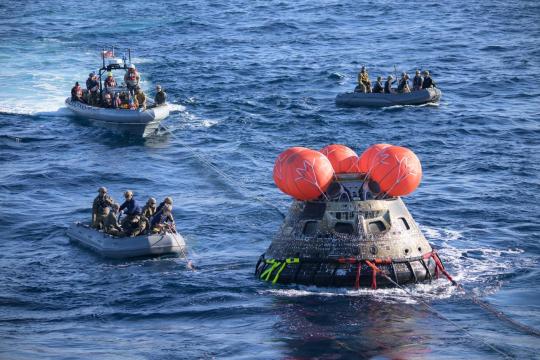
The Orion spacecraft arrived back home to planet Earth on Dec. 11, 2022. During re-entry, Orion endured temperatures about half as hot as the surface of the Sun at about 5,000 degrees Fahrenheit. Within about 20 minutes, Orion slowed from nearly 25,000 mph to about 20 mph for its parachute-assisted splashdown.

Recovery teams successfully retrieved the spacecraft and delivered it back to NASA’s Kennedy Space Center for de-servicing operations, which included removing the payloads (like Snoopy and Commander Moonikin Campos) and analyzing the heat shield.
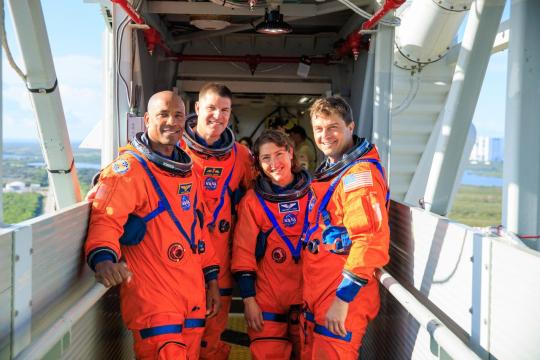
With the Artemis I mission under our belt, we look ahead to Artemis II — our first crewed mission to the Moon in over 50 years. Four astronauts will fly around the Moon inside Orion, practicing piloting the spacecraft and validating the spacecraft’s life support systems. The Artemis II crew includes: NASA astronauts Reid Wiseman, Victor Glover, and Christina Koch, and CSA astronaut Jeremy Hansen.
youtube
As we look ahead to Artemis II, we build upon the incredible success of the Artemis I mission and recognize the hard work and achievements of the entire Artemis team. Go Artemis!
Make sure to follow us on Tumblr for your regular dose of space!
#Artemis#Rocket#Anniversary#Launch#NASA#Space#Moon#Lunar#Astronaut#Apollo#Orion#Spacecraft#Space Launch System#STEM#science#tech#technology#on this day#Youtube
2K notes
·
View notes
Text

"Core Stage for Artemis II Rocket Moved to Pegasus Barge for Departure to Kennedy Space Center
This image shows team members moving the first core stage that will help launch the first crewed flight of NASA’s SLS (Space Launch System) rocket for the agency’s Artemis II mission. The move marked the first time a fully assembled Moon rocket stage for a crewed mission has rolled out from NASA’s Michoud Assembly Facility in New Orleans since the Apollo Program.
The core stage was moved onto the agency’s Pegasus barge, where it will be ferried to NASA’s Kennedy Space Center in Florida.
The core stage for the SLS mega rocket is the largest stage NASA has ever produced. At 212 feet tall, the stage consists of five major elements, including two huge propellant tanks that collectively hold more than 733,000 gallons of super chilled liquid propellant to feed four RS-25 engines at its base. During launch and flight, the stage will operate for just over eight minutes, producing more than 2 million pounds of thrust to help send a crew of four astronauts inside NASA’s Orion spacecraft onward to the Moon.
NASA is working to land the first woman, first person of color, and its first international partner astronaut on the Moon under Artemis. SLS is part of NASA’s backbone for deep space exploration, along with the Orion spacecraft and Gateway in orbit around the Moon and commercial human landing systems, next-generation space, next-generational spacesuits, and rovers on the lunar surface. SLS is the only rocket that can send Orion, astronauts, and supplies to the Moon in a single launch."
Credit: NASA
Date: July 16, 2024
Posted on Flickr by NASA's Marshall Space Flight Center: link
#Artemis 2#Artemis II#Space Launch System#SLS#Rocket#Artemis program#NASA#Marshall Space Flight Center#MSFC#Huntsville#Alabama#July#2024#my post
75 notes
·
View notes
Text




Truly nothing I've ever done can top spending an afternoon with @nasa Artemis II's SLS in the VAB. To think that this ship will be taking humans around the moon for the first time since the end of the Apollo program is so deeply poignant.
From top to bottom:
Exterior of the Vehicle Assembly Building (VAB), which all Apollo and Shuttle missions as well as Artemis I were assembled within
High bay ceiling within the VAB. It was so tall, I was actually getting dizzy!
The core stage of Artemis II, which will carry liquid fuel
The solid rocket boosters for Artemis II. The way they're constructed, with all the scaffolding around, it feels almost like Gothic architecture. Beautiful sight.
32 notes
·
View notes
Text

Got the fire going!
0 notes
Video
KSC-20240724-PH-JBP01_0034 by NASA Kennedy Via Flickr: In this aerial view, NASA’s Pegasus barge, carrying the agency’s massive SLS (Space Launch System) core stage, arrives at NASA’s Kennedy Space Center Complex 39 turn basin wharf in Florida on Tuesday, July 23, 2024, after journeying from the agency’s Michoud Assembly Facility in New Orleans. The core stage is the next piece of Artemis hardware to arrive at the spaceport and will be offloaded and moved to NASA Kennedy’s Vehicle Assembly Building, where it will be prepared for integration ahead of the Artemis II launch. Photo credit: NASA/Jamie Peer and Isaac Hutson NASA image use policy.
#Artemis#Artemis II#Core Stage#Crew#EGS#Exploration Ground Systems#Kennedy#Kennedy Space Center#Mars#Moon#NASA#Orion#Pegasus#Pegasus barge#SLS#Space Launch System#UAS#VAB#Vehicle Assembly Building#barge#drone#flickr
1 note
·
View note
Text
What's next for NASA's Artemis program?
The Artemis 1 Space Launch System (SLS) rocket at Kennedy Space Center’s (KSC) Launch Pad 39B, on the morning of March 18, 2022. Credit: Scott Johnson / Spaceflight Insider KENNEDY SPACE CENTER, Fla. — Late last year, NASA successfully launched its first Space Launch System rocket, propelling an uncrewed Orion capsule on a flight to a distant retrograde orbit around the Moon. That was Artemis…
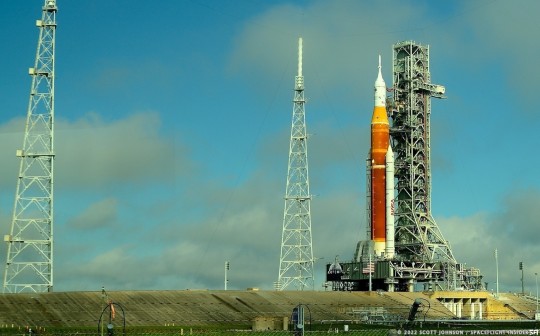
View On WordPress
#Artemis 2#Artemis 3#Artemis program#Human Space Flight#Kennedy Space Center#Marshall Space Flight Center#NASA#Orion#Space Launch System#SpaceX#The Range#United Launch Alliance
3 notes
·
View notes

